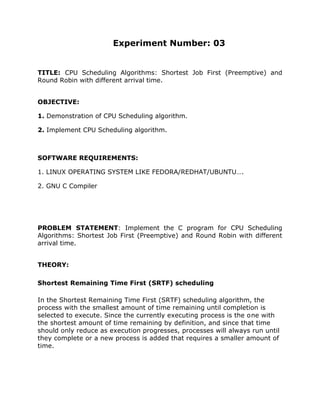
exp 3.docx
- 1. Experiment Number: 03 TITLE: CPU Scheduling Algorithms: Shortest Job First (Preemptive) and Round Robin with different arrival time. OBJECTIVE: 1. Demonstration of CPU Scheduling algorithm. 2. Implement CPU Scheduling algorithm. SOFTWARE REQUIREMENTS: 1. LINUX OPERATING SYSTEM LIKE FEDORA/REDHAT/UBUNTU…. 2. GNU C Compiler PROBLEM STATEMENT: Implement the C program for CPU Scheduling Algorithms: Shortest Job First (Preemptive) and Round Robin with different arrival time. THEORY: Shortest Remaining Time First (SRTF) scheduling In the Shortest Remaining Time First (SRTF) scheduling algorithm, the process with the smallest amount of time remaining until completion is selected to execute. Since the currently executing process is the one with the shortest amount of time remaining by definition, and since that time should only reduce as execution progresses, processes will always run until they complete or a new process is added that requires a smaller amount of time.
- 2. Advantage: 1- Short processes are handled very quickly. 2- The system also requires very little overhead since it only makes a decision when a process completes or a new process is added. 3- When a new process is added the algorithm only needs to compare the currently executing process with the new process, ignoring all other processes currently waiting to execute. Disadvantage: 1- Like shortest job first, it has the potential for process starvation. 2- Long processes may be held off indefinitely if short processes are continually added. How to compute below times in SJF using a program? 1. Completion Time: Time at which process completes its execution. 2. Turn Around Time: Time Difference between completion time and arrival time. Turn Around Time = Completion Time – Arrival Time 3. Waiting Time(W.T): Time Difference between turn around time and burst time. Waiting Time = Turn Around Time – Burst Time SJF CPU SCHEDULING ALGORITHM : For SJF scheduling algorithm, read the number of processes/jobs in the system, their CPU burst times. Arrange all the jobs in order with respect to their burst times. There may be two jobs in queue with the same execution time, and then FCFS approach is to be performed. Each process will be executed according to the length of its burst time. Then calculate the waiting time and turnaround time of each of the processes accordingly. ROUND ROBIN CPU SCHEDULING ALGORITHM: The name of this algorithm comes from the round-robin principle, where each person gets an equal share of something in turns. It is the oldest, simplest scheduling algorithm, which is mostly used for multitasking. In Round-robin scheduling, each ready task runs turn by turn only in a cyclic queue for a limited time slice. This algorithm also offers starvation free execution of processes.
- 3. For round robin scheduling algorithm, read the number of processes/jobs in the system, their CPU burst times, and the size of the time slice. Time slices are assigned to each process in equal portions and in circular order, handling all processes execution. This allows every process to get an equal chance. Calculate the waiting time and turnaround time of each of the processes accordingly. Characteristics of Round-Robin Scheduling Here are the important characteristics of Round-Robin Scheduling: Round robin is a pre-emptive algorithm The CPU is shifted to the next process after fixed interval time, which is called time quantum/time slice. The process that is preempted is added to the end of the queue. Round robin is a hybrid model which is clock-driven Time slice should be minimum, which is assigned for a specific task that needs to be processed. However, it may differ OS to OS. It is a real time algorithm which responds to the event within a specific time limit. Round robin is one of the oldest, fairest, and easiest algorithm. Widely used scheduling method in traditional OS. ALGORITHM 1. Start 2. Declare the array size 3. Read the number of processes to be inserted 4. Read the burst times of the processes 5. Read the Time Quantum 6. If the burst time of a process is greater than time Quantum then subtract time quantum form the burst time Else Assign the burst time to time quantum. 7. Calculate the average waiting time and turnaround time of the processes. 8. Display the values 9. Stop Note : Solve one example of each algorithm. CONCLUSION (At least three points):
- 4. 1. Understood what is CPU scheduling. 2. Studied concept of Preemptive and non-preemptive scheduling. 3. Studied and implemented CPU scheduling algorithm. REFERENCES: 1. Abraham Silberschatz, Peter Baer Galvin and Greg Gagne, Operating System Concepts, John Wiley & Sons ,Inc., 9th Edition
